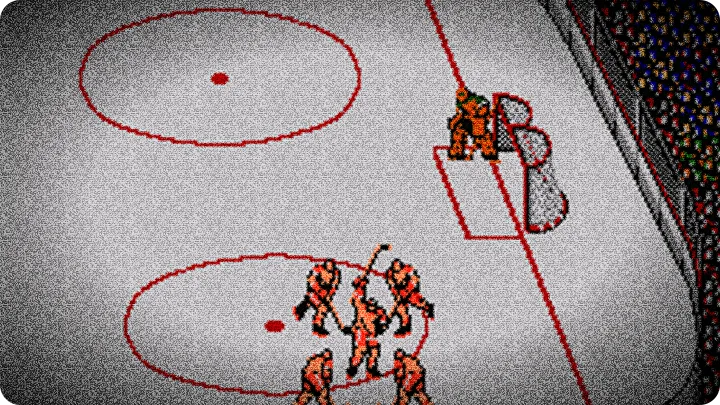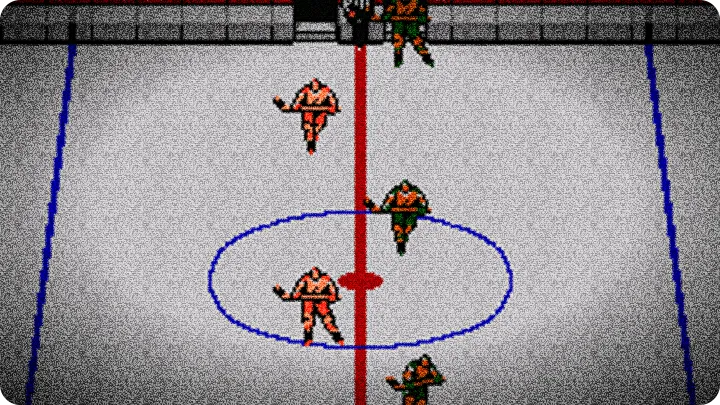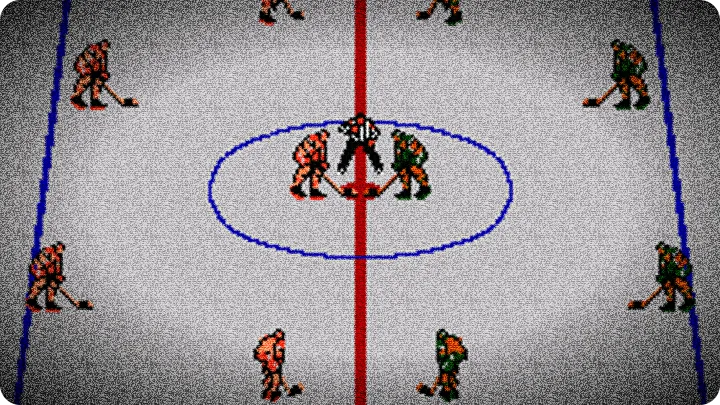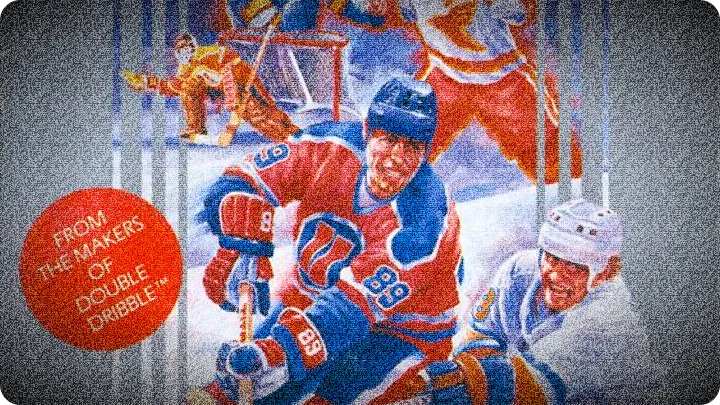 The cartridge snaps in with a satisfying click, and the title screen music hits—Konami again. Fun fact: Konami cut its teeth in the arcades of the early 1980s. That history shows in Blades of Steel’s arcade-first design choices—quick, theatrical fights and bursts of digitized voice. It feels like they brought cabinet showmanship straight into the living room in 1988.
The cartridge snaps in with a satisfying click, and the title screen music hits—Konami again. Fun fact: Konami cut its teeth in the arcades of the early 1980s. That history shows in Blades of Steel’s arcade-first design choices—quick, theatrical fights and bursts of digitized voice. It feels like they brought cabinet showmanship straight into the living room in 1988.
 I already appreciate that. The opening throw looks and sounds like an arcade port, not a buttoned-down sports sim. There’s no team customization or stat management—Konami chose immediacy over bookkeeping. That keeps the focus on playing: passing, shooting, checking, and, yes, the occasional fight.
I already appreciate that. The opening throw looks and sounds like an arcade port, not a buttoned-down sports sim. There’s no team customization or stat management—Konami chose immediacy over bookkeeping. That keeps the focus on playing: passing, shooting, checking, and, yes, the occasional fight.
 Let’s talk gameplay highlights. The controls are direct and responsive—skating diagonally, tipping passes, and timing slapshots feels natural. The slightly diagonal-down camera adds speed and arcade flair. Passing feels reliable, and shots carry weight: wrist shots, slapshots, and even desperate backhands all feel distinct.
Let’s talk gameplay highlights. The controls are direct and responsive—skating diagonally, tipping passes, and timing slapshots feels natural. The slightly diagonal-down camera adds speed and arcade flair. Passing feels reliable, and shots carry weight: wrist shots, slapshots, and even desperate backhands all feel distinct.

 Two-player mode is where the game shines. Playing against a human is immediate and thrilling. Momentum swings fast, and fights change the rhythm dramatically. The fight sequences are neat spectacles—close-up sprites, selectable punches, and a short contest where the loser heads to the box. They’re not deep like a fighting game, but they break up the action with flair.
Two-player mode is where the game shines. Playing against a human is immediate and thrilling. Momentum swings fast, and fights change the rhythm dramatically. The fight sequences are neat spectacles—close-up sprites, selectable punches, and a short contest where the loser heads to the box. They’re not deep like a fighting game, but they break up the action with flair.
 Now, the candid part. Overall, this earns a B. There are plenty of enjoyable elements but also some rough edges. The AI in single-player is competitive yet predictable after a few games. Defenders sometimes behave oddly—tracking back as if magnetically pulled. Worse, every team feels the same. That lack of variety hurts long-term replay value once the mechanics are mastered.
Now, the candid part. Overall, this earns a B. There are plenty of enjoyable elements but also some rough edges. The AI in single-player is competitive yet predictable after a few games. Defenders sometimes behave oddly—tracking back as if magnetically pulled. Worse, every team feels the same. That lack of variety hurts long-term replay value once the mechanics are mastered.
 Presentation is bold for a sports title in 1988—digitized voices and icy crowd noise give it arcade polish. But graphics turn muddy in the neutral zone. Player sprites overlap, and it can be hard to tell who has the puck. It’s a small but constant frustration, especially when passes misfire.
Presentation is bold for a sports title in 1988—digitized voices and icy crowd noise give it arcade polish. But graphics turn muddy in the neutral zone. Player sprites overlap, and it can be hard to tell who has the puck. It’s a small but constant frustration, especially when passes misfire.

- Gameplay Highlights: Tight controls, satisfying shot mechanics, two-player competitive fun, and memorable fight sequences.
- Shortcomings: Limited team variety, occasional sprite clarity issues, and an AI that becomes predictable.
 Hot tips, as we cycle down the ice: timing a shot immediately after receiving a pass yields the best scoring chance; hold off on slapshots from the blue line unless you have traffic in front of the net. Use the body check not as a glorified tackle button but to create turnovers near the boards. And when a fight starts, be deliberate—there is no pointless button-mashing. A well-timed punch or block gets you the advantage and keeps your best player on the ice.
Hot tips, as we cycle down the ice: timing a shot immediately after receiving a pass yields the best scoring chance; hold off on slapshots from the blue line unless you have traffic in front of the net. Use the body check not as a glorified tackle button but to create turnovers near the boards. And when a fight starts, be deliberate—there is no pointless button-mashing. A well-timed punch or block gets you the advantage and keeps your best player on the ice.
- Hot Tip 1: Pass to the slot quickly—shots from close range are far more effective than long slapshots.
- Hot Tip 2: Use the fight sequence to sacrifice a lesser player if you need to keep your scorer on the ice.
- Hot Tip 3: Watch for icing calls; they can spoil a momentum play if you chase the puck from your zone.
 Memorable moments? There is a match we just finished where the clock wound down and we tied it in the last fifteen seconds with a clever give-and-go. Then, the opponent starts a brawl with our star. The miniature fight felt cinematic—the referee threatens to break it up, the sprites trade punches, and we win, sending the other player to the box. That penalty allowed us to score on the powerplay and clinch the win. It felt exactly like a dramatic arcade moment rather than a simulation stat line.
Memorable moments? There is a match we just finished where the clock wound down and we tied it in the last fifteen seconds with a clever give-and-go. Then, the opponent starts a brawl with our star. The miniature fight felt cinematic—the referee threatens to break it up, the sprites trade punches, and we win, sending the other player to the box. That penalty allowed us to score on the powerplay and clinch the win. It felt exactly like a dramatic arcade moment rather than a simulation stat line.
 And the tournament final—the closest equivalent to a final boss in this game—is mercilessly enjoyable. The CPU’s last opponent plays like an all-star team: they forecheck hard, they collapse on rebounds, and they will punish hesitation. We faced them in overtime. The final sequence was tense: a blocked pass, a quick turnover, a breakaway, and a backhand into the corner of the net. The explosion of digitized cheering and that short voice clip make it feel like an arcade crowd going wild. The final boss is less a single player and more the gauntlet of pressure: managing stamina through penalties, avoiding icing, and making that single decisive play.
And the tournament final—the closest equivalent to a final boss in this game—is mercilessly enjoyable. The CPU’s last opponent plays like an all-star team: they forecheck hard, they collapse on rebounds, and they will punish hesitation. We faced them in overtime. The final sequence was tense: a blocked pass, a quick turnover, a breakaway, and a backhand into the corner of the net. The explosion of digitized cheering and that short voice clip make it feel like an arcade crowd going wild. The final boss is less a single player and more the gauntlet of pressure: managing stamina through penalties, avoiding icing, and making that single decisive play.

 In summary, Blades of Steel offers a highly enjoyable, fast-paced arcade hockey experience with strong local two-player appeal. It is not a deep manager’s simulator, but it does not pretend to be. If you value immediacy, memorable mini-spectacles like the fights, and a game that feels like an arcade cabinet ported home, you will enjoy it. If you want deep team customization or nuanced AI behaviors, you will find it wanting.
In summary, Blades of Steel offers a highly enjoyable, fast-paced arcade hockey experience with strong local two-player appeal. It is not a deep manager’s simulator, but it does not pretend to be. If you value immediacy, memorable mini-spectacles like the fights, and a game that feels like an arcade cabinet ported home, you will enjoy it. If you want deep team customization or nuanced AI behaviors, you will find it wanting.
 A solid B—celebrate its strengths, be frank about its limits. Now, your move. I am ready to take you on again.
A solid B—celebrate its strengths, be frank about its limits. Now, your move. I am ready to take you on again.
more info and data about Blades of Steel provided by mobyGames.com

